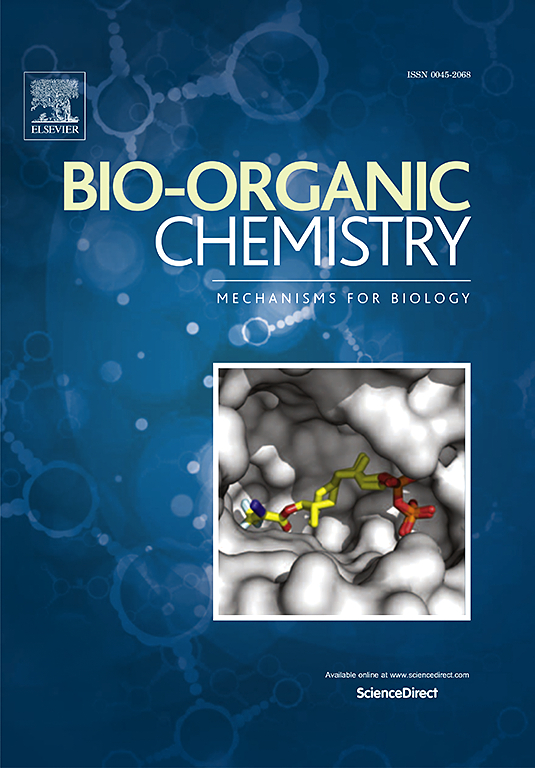苯萘-2-磺酸基硫代氨基脲作为潜在碳酸酐酶抑制剂的合成、生物学评价和硅研究。
IF 4.5
2区 医学
Q1 BIOCHEMISTRY & MOLECULAR BIOLOGY
引用次数: 0
摘要
合成了一系列新型苯基萘-2-磺酸基硫代氨基脲类化合物(5a-v),并测定了它们对人碳酸酐酶I和II (hCA I和hCA II)的抑制活性,其中化合物5d和5p的IC50值最高,分别为4.32±0.02 nM和5.24±0.03 nM, 3.89±0.01 nM和4.72±0.01 nM。值得注意的是,化合物5d的效价优于对照药乙酰唑胺。构效关系(SAR)分析表明,吸电子基团,特别是5d和5p中的二氯苯基,增强了抑制活性。分子对接和分子动力学模拟证实了化合物5d的高结合亲和力,对hCA I和hCA II的对接得分分别为-9.7 kcal/mol和-9.5 kcal/mol。MD模拟的稳定性进一步支持了其有效的抑制作用。ADMET预测表明,化合物5d和5p具有良好的药代动力学特征。综上所述,基于苯萘-2-磺酸盐的硫代氨基脲,特别是化合物5d,作为hCA I和hCA II的治疗药物具有很强的潜力。本文章由计算机程序翻译,如有差异,请以英文原文为准。

Synthesis, biological evaluation, and in silico studies of phenyl naphthalene-2-sulfonate derived thiosemicarbazones as potential carbonic anhydrase inhibitors
A series of novel phenyl naphthalene-2-sulfonate-based thiosemicarbazones (5a-v) were synthesized and evaluated for their inhibitory activity against human carbonic anhydrases I and II (hCA I and hCA II). Compounds 5d and 5p demonstrated the highest inhibitory potency, with IC50 values of 4.32 ± 0.02 nM and 5.24 ± 0.03 nM for hCA I, and 3.89 ± 0.01 nM and 4.72 ± 0.01 nM for hCA II, respectively. Notably, compound 5d exhibited superior potency compared to the reference drug acetazolamide. The structure–activity relationship (SAR) analysis revealed that electron-withdrawing groups, particularly the dichlorophenyl group in 5d and 5p, enhanced inhibitory activity. Molecular docking and molecular dynamics simulations confirmed the high binding affinity of compound 5d, with docking scores of −9.7 kcal/mol for hCA I and −9.5 kcal/mol for hCA II. Stability in MD simulations further supported its potent inhibitory action. ADMET predictions suggested that compounds 5d and 5p have favorable pharmacokinetic profiles. In conclusion, phenyl naphthalene-2-sulfonate-based thiosemicarbazones, especially compound 5d, show strong potential as therapeutic agents targeting hCA I and hCA II.
求助全文
通过发布文献求助,成功后即可免费获取论文全文。
去求助
来源期刊

Bioorganic Chemistry
生物-生化与分子生物学
CiteScore
9.70
自引率
3.90%
发文量
679
审稿时长
31 days
期刊介绍:
Bioorganic Chemistry publishes research that addresses biological questions at the molecular level, using organic chemistry and principles of physical organic chemistry. The scope of the journal covers a range of topics at the organic chemistry-biology interface, including: enzyme catalysis, biotransformation and enzyme inhibition; nucleic acids chemistry; medicinal chemistry; natural product chemistry, natural product synthesis and natural product biosynthesis; antimicrobial agents; lipid and peptide chemistry; biophysical chemistry; biological probes; bio-orthogonal chemistry and biomimetic chemistry.
For manuscripts dealing with synthetic bioactive compounds, the Journal requires that the molecular target of the compounds described must be known, and must be demonstrated experimentally in the manuscript. For studies involving natural products, if the molecular target is unknown, some data beyond simple cell-based toxicity studies to provide insight into the mechanism of action is required. Studies supported by molecular docking are welcome, but must be supported by experimental data. The Journal does not consider manuscripts that are purely theoretical or computational in nature.
The Journal publishes regular articles, short communications and reviews. Reviews are normally invited by Editors or Editorial Board members. Authors of unsolicited reviews should first contact an Editor or Editorial Board member to determine whether the proposed article is within the scope of the Journal.
 求助内容:
求助内容: 应助结果提醒方式:
应助结果提醒方式:


